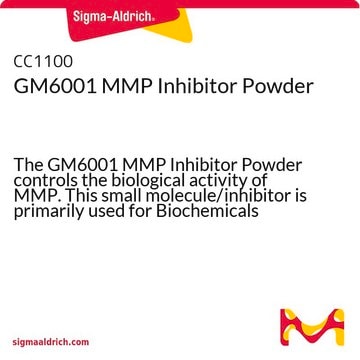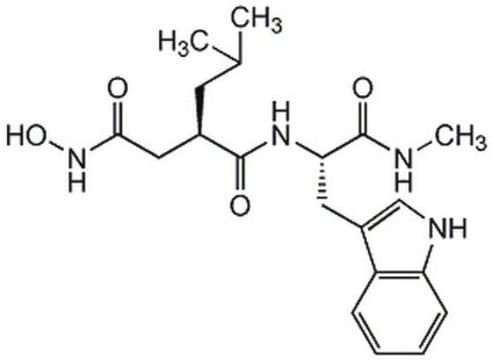PZ0198
Prinomastat hydrochloride
≥95% (HPLC)
Synonim(y):
(S)-2,2-Dimethyl-4-((p-(4-pyridyloxy)phenyl)sulfonyl)-3-thiomorpholinecarbohydroxamic acid hydrochloride, AG 3340 hydrochloride, AG-3340 hydrochloride, AG3340 hydrochloride
About This Item
Polecane produkty
Próba
≥95% (HPLC)
Postać
powder
warunki przechowywania
desiccated
kolor
white to beige
rozpuszczalność
H2O: 15 mg/mL (clear solution)
temp. przechowywania
room temp
ciąg SMILES
Cl.CC1(C)SCCN([C@H]1C(=O)NO)S(=O)(=O)c2ccc(Oc3ccncc3)cc2
InChI
1S/C18H21N3O5S2.ClH/c1-18(2)16(17(22)20-23)21(11-12-27-18)28(24,25)15-5-3-13(4-6-15)26-14-7-9-19-10-8-14;/h3-10,16,23H,11-12H2,1-2H3,(H,20,22);1H/t16-;/m0./s1
Klucz InChI
UQGWXXLNXBRNBU-NTISSMGPSA-N
Opis ogólny
Zastosowanie
Działania biochem./fizjol.
Hasło ostrzegawcze
Danger
Zwroty wskazujące rodzaj zagrożenia
Zwroty wskazujące środki ostrożności
Klasyfikacja zagrożeń
Repr. 1B
Kod klasy składowania
6.1C - Combustible acute toxic Cat.3 / toxic compounds or compounds which causing chronic effects
Klasa zagrożenia wodnego (WGK)
WGK 3
Temperatura zapłonu (°F)
Not applicable
Temperatura zapłonu (°C)
Not applicable
Certyfikaty analizy (CoA)
Poszukaj Certyfikaty analizy (CoA), wpisując numer partii/serii produktów. Numery serii i partii można znaleźć na etykiecie produktu po słowach „seria” lub „partia”.
Masz już ten produkt?
Dokumenty związane z niedawno zakupionymi produktami zostały zamieszczone w Bibliotece dokumentów.
Nasz zespół naukowców ma doświadczenie we wszystkich obszarach badań, w tym w naukach przyrodniczych, materiałoznawstwie, syntezie chemicznej, chromatografii, analityce i wielu innych dziedzinach.
Skontaktuj się z zespołem ds. pomocy technicznej








